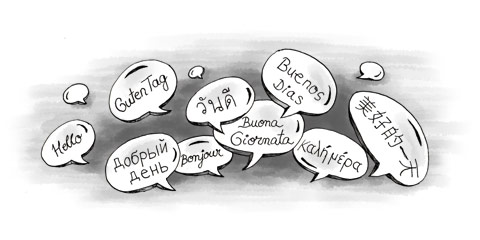Learning to read and write Japanese is a time-consuming, if ultimately rewarding process. It is easiest to understand the rules of spoken Japanese once you have a rough idea how written Japanese works.
Japanese characters
There are two basic sets of characters in Japanese: kana and kanji.
Kana characters are the closest thing to a western alphabet that exists in Japanese. Unlike letters in western alphabets, however, kana represent sounds, and not all western sounds are represented. This is why Japanese speakers find it difficult to pronounce many western words when first learning foreign languages. There is no kana for the “L” sound, for instance, which is probably the most notorious example of all.
There are two styles of kana: katakana and hiragana. The meanings and pronunciations of both are the same, though they are written in different styles. The difference is similar to the difference between cursive and printed handwriting in other languages. Hiragana are used for writing Japanese words, while katakana are used for western words imported into Japanese. Menus in foreign-style restaurants are examples of where you will find katakana in Japan and your name will be written in katakana, unless you happen to have a Japanese name!
There are 46 Japanese kana, and most Japanese children have mastered them by the end of first grade.
Kanji characters are considerably more complicated. These are symbolic characters that represent specific words and concepts. They were imported from Chinese around 600 AD and, although the total number of Kanji characters is disputed, there is said to be more than 50,000. The Japanese Ministry of Education compiled a list of 1,945 kanji characters, which are the most commonly used - considered the minimum number required for adult literacy. It takes Japanese children 9 years to learn the kanji. Since most Japanese publications are written in kanji, do not expect to read anything more complicated than signs fluently until you have learned the most common kanji.
Spoken Japanese
Unlike most Asian languages which tend to be tonal, Japanese uses pitch accents to express different words which would otherwise be phonetically identical. Pitch accent means that after an accented syllable (or mora), the pitch falls. The words differ depending on which syllable this drop in pitch follows. The canonical example is seen in the Japanese word for "chopsticks", hashi, which has the accent on the first syllable. If you do not emphasize the pitch drop following the first syllable, hashi could mean "bridge", which has the accent on the second syllable, or "edge", which has no accent.
Most words, however, do not use pitch accent and for this reason, you may have noticed that Japanese people tend to speak in a somewhat monotone voice and a controlled rhythm. This is necessary in order to differentiate clearly between the words that contain pitch accents from the ones that do not.
Japanese people
Japan is nearly completely homogeneous in terms of its population. 99% of the population is registered as Japanese, with only 1% registered as foreign (yes, you will feel lonely out there) and there is nearly full literacy in the country. Everyone speaks and understands the same language (nihongo).
This homogeneity comes from a desire to eradicate discrimination by declaring everyone equal. However, there exist various groups within the country who are not entirely Japanese: the Ainu and the Ryukyuan (respectively from Hokkaido and Okinawa). The Ainu language, however, is only spoken and by very few people, as such, you are more than unlikely to encounter it. The Ryukyuans do not have a separate language, and although Okinawan Japanese differs from mainland Japanese in many aspects, they are still understandable.
Japanese dialects & accents
Japan is made up of over 6,800 islands in all, and many of those are mountainous. As a result, numerous variations have developed over the centuries. In Japan, it is not correct to refer to the differences in language as dialects, as they are the same language with the same vocabulary, albeit with a few grammatical differences and variations in pitch accents.
The Tokyo accent is normally taught in all language schools, although it is also very common to hear the Osaka accent. Japanese people in all major cities will be able to speak and understand these accents, which are regarded as being clearer. However, this is not true of people living in the countryside or outlying islands, who tend to develop their own mannerisms and you are likely to find yourself wondering what gibberish they are saying, especially if your level of Japanese is not so good, but fear not – they are generally just as confused! If you plan on travelling to any remote area, you will very likely find yourself in a tight spot, and even being with a Japanese friend might not make that much difference...


